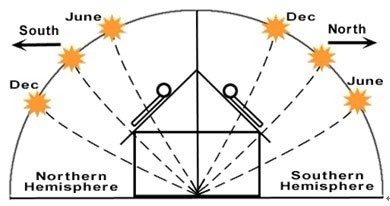You are here: > Home > Project > Solar hot water project information
System operating principle
Most solar hot water systems use solar collectors or panels to absorb energy from the sun. Water is heated by the sun as it passes through the collectors. It then flows into an insulated storage tank for later use.
In passive systems, water flows due to a thermosiphon effect between the collectors and the tank. In active systems, water is pumped between the collectors and the tank.
The storage tank is usually fitted with an electric, gas or solid fuel booster that heats the water when sunlight is insufficient. Some solar water heaters also have frost protection to prevent damage in frost prone areas.
Water heating accounts for 25 per cent of the energy used in an average home and is responsible for 23 per cent of the total greenhouse gas emissions from home energy use. Reducing your hot water use and using renewable energy sources to heat water are great ways to reduce your environmental impact. By installing the most appropriate and efficient water heater for your household size and water use patterns you can save money and reduce greenhouse gas emissions without compromising your lifestyle. An efficient hot water system can also add value to your home and help you to meet local council or state/territory regulations.
Purpose
Solar center heating project for school, hotel, swimming pool
Many solar thermal collectors can be linked together for making solar central heating project, such as in hotel, school, even swimming pool which need a lot of hot water every day.
The project capacity can be from 1000L-100000L, It needs solar collectors, storage tank, controller, circulation pump and pipeline etc to be combined with.
An assistant heating system, such as heat pump, boiler can be connected with, to provide the hot water in everytime.
Design and installation
The angle and direction of installation is also of great importance as it will effect the efficiency of the solar collector. Naturally you want the collector to receive the maximum amount of sunlight each day and throughout the year. As a general rule if you are in the Northern Hemisphere then the collector should face South and if you are in the Southern Hemisphere then the collector should face North. See diagram below.
The angle at which you mount the collector should roughly correspond to the latitude of your location. For example:
- Melbourne, Australia has a latitude of 37o South - the collector should therefore face north at a 37o angle.
- London, UK has a latitude of 51o North - the collector should therefore face south at a 51o angle.

System operating principle
Most solar hot water systems use solar collectors or panels to absorb energy from the sun. Water is heated by the sun as it passes through the collectors. It then flows into an insulated storage tank for later use.
In passive systems, water flows due to a thermosiphon effect between the collectors and the tank. In active systems, water is pumped between the collectors and the tank.
The storage tank is usually fitted with an electric, gas or solid fuel booster that heats the water when sunlight is insufficient. Some solar water heaters also have frost protection to prevent damage in frost prone areas.
Water heating accounts for 25 per cent of the energy used in an average home and is responsible for 23 per cent of the total greenhouse gas emissions from home energy use. Reducing your hot water use and using renewable energy sources to heat water are great ways to reduce your environmental impact. By installing the most appropriate and efficient water heater for your household size and water use patterns you can save money and reduce greenhouse gas emissions without compromising your lifestyle. An efficient hot water system can also add value to your home and help you to meet local council or state/territory regulations.
Purpose
Solar center heating project for school, hotel, swimming pool
Many solar thermal collectors can be linked together for making solar central heating project, such as in hotel, school, even swimming pool which need a lot of hot water every day.
The project capacity can be from 1000L-100000L, It needs solar collectors, storage tank, controller, circulation pump and pipeline etc to be combined with.
An assistant heating system, such as heat pump, boiler can be connected with, to provide the hot water in everytime.
Design and installation
The angle and direction of installation is also of great importance as it will effect the efficiency of the solar collector. Naturally you want the collector to receive the maximum amount of sunlight each day and throughout the year. As a general rule if you are in the Northern Hemisphere then the collector should face South and if you are in the Southern Hemisphere then the collector should face North. See diagram below.
The angle at which you mount the collector should roughly correspond to the latitude of your location. For example:
- Melbourne, Australia has a latitude of 37o South - the collector should therefore face north at a 37o angle.
- London, UK has a latitude of 51o North - the collector should therefore face south at a 51o angle.